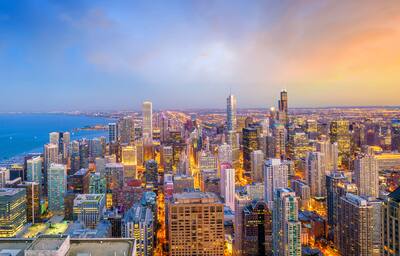
A Traveling Insider’s Guide To Chicago
Allow us to help you navigate your Chicago vacation using this guide to the Windy City. | By Paul Oswell | August 13, 2021 (Updated March 10, 2023)
Chicago is a quintessential American city, a diverse concoction of urban grit and high finance, towering skyscrapers, vibrant immigrant communities and thriving suburbs.
Defined by its proximity to Lake Michigan, its expansion and growth have transformed it into a welcoming and multi-faceted destination. Over the last 100 years, Chicago shed its early 20th-century reputation as a home to mob bosses and a Prohibition battleground, but it has kept its unique edge.
So what are you waiting for? Here’s our guide to enjoying this beautiful town, including:
- Water ways: Enjoy the parks and beaches along the huge stretches of coastline that frame Lake Michigan, a natural outdoor resource for the city.
- City sights: Chicago’s architecture and skyline are among the country’s most alluring, and there are dozens of great public artworks to enjoy.
- Cultural classics: From the performing arts of Symphony Hall to the home runs at Wrigley Field, you have your pick of entertainment options.
Why should you visit Chicago?
Chicago has a big reputation and, with almost 3 million residents, it’s a big city. Thankfully for first-time visitors, most of the city’s attractions are concentrated within a manageable distance, so you can fit in the hotspots over a few days.
The city boasts a rich architectural heritage. It was the home of the first skyscraper, as well as notable buildings such as the Willis Tower. The Willis Tower was the tallest building in the Western Hemisphere for 40 years — and the Oak Park collection of Frank Lloyd Wright’s work.
Museums, art, music and must-try eateries abound. If you have some extra days, you'll find charmingly characterful neighborhoods in Greek Town, Chinatown, Little Italy and West Town.
Park place
The city’s 570 parks — yes, you read that right — help add natural beauty between the dense neighborhoods. Lincoln Park alone stretches for some 1,200 acres, and the lawns and festivals of Millennium Park and Grant Park welcome thousands of people every week.
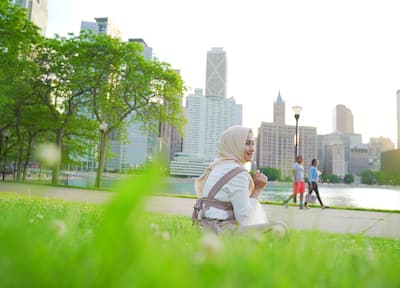
The “City In a Garden” references not only its extensive green spaces, but also the shores of Lake Michigan. Few large American cities enjoy close access to such huge swathes of shoreline. You’ll find 24 beaches, with North Avenue Beach being by far the most popular. In the summer months, the volleyball games and DJs make it indistinguishable from its Californian cousins. For a more mellow, family experience, check out 57th Street Beach, or visit Montrose Beach for watersports.
Chicago is also a city of culture, with more than 200 theaters and music clubs alone. The jazz and blues scene is alive and well here, including legendary venues such as the Green Mill and Winter’s Jazz Club. For a change of pace, there’s the Lyric Opera of Chicago and the Chicago Symphony Orchestra.
Theater at the Steppenwolf and comedy at places such as The Second City enjoy huge audiences here. The Art Institute of Chicago houses works by Monet, Degas and Van Gogh, while the Museum of Science and Industry celebrates the city’s blue-collar roots.
Slice of life
Deep-dish pizza reigns supreme in Chicago, and locals have fierce loyalties as to where the best pizza can be found (check out Lou Malnati's, Giordano’s, Labriola’s and Gino’s East, to name several of many).
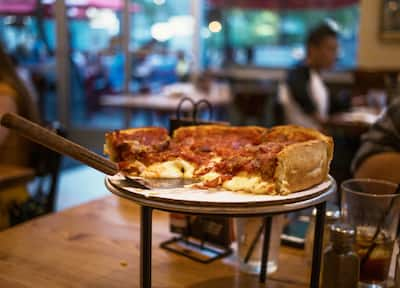
Chicago also has its own barbecue, hot dogs and sandwich styles. You won’t find better old-school steakhouses than those typified by Gene & Georgetti (established in 1941), but there are cutting-edge restaurants to explore as well. If you have a sweet tooth, brownies were invented here (at the Palmer House Hilton, no less!), so plan to stop in for a visit.
When is the best time for your trip to Chicago?
They don’t call Chicago the Windy City for nothing — the famously frigid Chicago winters mean that you’ll likely need an extra piece of luggage just for your winter clothes. Spring and fall (April through May and September to October) are the most pleasant times in the city, with warm weather, manageable visitor numbers and a good range of festivals and events. Summers are very busy; higher temperatures and the lake means that every slice of parkland and beach is suddenly prime lounging real estate.
Getting to and around Chicago
O’Hare International Airport is one of the busiest in the world and is a hub for hundreds of domestic and international flights. It is 20 miles or so northwest of downtown Chicago. The Chicago Transit Authority’s (CTA) Blue Line train connects O’Hare to downtown. Taxis and ride-hailing apps are both operational, and driving downtown takes around 40 minutes with minimal traffic--but double that during peak times.
Chicago Midway International Airport is the city’s second airport hub, serving mostly domestic flights. The CTA’s Orange Line train connects Midway to downtown. GO Airport Express offers a shuttle service from both airports, stopping at requested stops downtown.
The CTA train network is known as the “L” (short for elevated train) and has eight lines, identifiable by color, that connect many parts of the city. Some lines run 24 hours per day. A regular fare is $2.50 but you can also buy Ventra transit cards for topping up or to use as day passes.
Union Station is centrally located and is well served by around 60 Amtrak services. The commuter rail service serves the suburbs and is called Metra. The CTA bus service covers the entire city.
Pedal power
Chicago is a great city to bike around, with more than 200 miles of bike lanes and Divvy, a bike-share program. Walking is also encouraged, particularly around downtown and Northside.

Unless you have further travels planned, it’s best to avoid the stress and expense of a car rental, and traveling between neighborhoods is easy by either taxi, public transportation or ride-hailing services.
Things to do in Chicago
The city is rightly proud of its buildings, and we recommend taking an architectural tour to learn more about them; there are several options, including walking to and from the water. The Rookery and The Reliance Building are a couple of the world’s oldest skyscrapers, and 875 North Michigan Avenue (previously called the John Hancock Center) and Marina City are awe-inspiring.
It’s worth lining up for the Skydeck at the Willis Tower (originally known as the Sears Tower) to enjoy the most breathtaking view of the city. For a rare opportunity to stand on a sandy beach with the skyline in the background, head to North Avenue Beach.
Chicago is home to the largest art museum in the Midwest, the Art Institute of Chicago. Its glorious beaux-arts exterior beckons visitors to explore its huge collection, some 260,000 pieces. Among the highlights in the Art Institute of Chicago are the iconic “American Gothic” by Grant Wood, “Nighthawks” by Edward Hopper and an incredible collection of impressionist and post-impressionist works.
The Field Museum is an endlessly fascinating collection of cultural treasures from around the world, while the family-friendly Museum of Science and Industry was the first museum to have interactive exhibits, some dating back to the 1930s.
Five of the city’s most popular attractions are contained on Museum Campus, which spans 57 acres within Grant Park. The campus houses the Adler Planetarium (which is partly closed until March 2022), the Shedd Aquarium, the Field Museum, Soldier Field (home of the Chicago Bears football team) and the Lakeside Center of McCormick Place.
Public art
The city’s public art is among the best in the world, with the most prominent examples being the untitled Picasso sculpture at Daley Plaza, and the 53-foot tall “Flamingo” sculpture by Alexander Calder at the Federal Plaza. Perhaps the best known is “Cloud Gate” (affectionately referred to as ”The Bean”) by Anish Kapoor, a huge, abstract shape that is covered in reflective stainless steel.
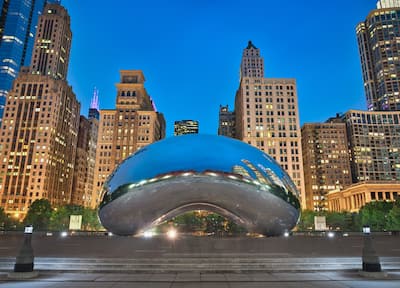
Proximity to nature means that wildlife is also an important part of city life here. The beautiful beaux-arts Shedd Aquarium has been welcoming visitors since 1929, and is home to 32,000 marine animals representing over 2,000 species. The glass-walled Oceanarium has an infinity-pool effect that stretches out over Lake Michigan. Lincoln Park Zoo dates back to 1868 when it opened with a pair of swans. It’s a free facility, with a bird house, a polar bear pool and the exotic Regenstein African Journey exhibit, with rhinos, hippos and giraffes.
Among the performing arts heavy hitters are the Goodman Theatre (founded in 1925) and the Chicago Shakespeare Theater, the cultural versatility of which stretches beyond the Bard’s works. Comedy fans will likely want to make a pilgrimage to The Second City to see the institution that birthed comedic legends.
Chicagoans are as fervent sports fans as you’ll find anywhere, and it’s always fun to take in a game, whether it’s the Bears (football), the Bulls (basketball) the Cubs or the White Sox (both baseball). The Cubs play at one of the few remaining original Major League ballparks, Wrigley Field.
Many modern cities have a redeveloped waterfront area that has been transformed into an entertainment, dining and retail center, and Chicago’s is Navy Pier. Renovated for its 2016 centennial, Navy Pier now boasts fairground rides, interactive water features, the Chicago Children’s Museum and the Centennial Wheel, a 200-foot-tall Ferris wheel that delivers sensational lake and city views.
The art deco facades of State Street may be reproductions, but its allure as a shopping haven stretches back over a century, and Macy’s has been there since 1907. Oak Street caters to the designer names set, while Andersonville and Bucktown Neighborhood are home to smaller boutiques and purveyors of vintage chic.
Magnificent Mile
The Magnificent Mile dominates the local shopping scene with a mile of department stores along North Michigan Avenue.

Chicago has such explorable neighborhoods. The Loop is the most central, named for the elevated train tracks that surround it — it’s the cultural dynamo of the city. Near North is a densely-packed historical district with fine architecture and art galleries. Northside has upscale dining and theater, as well as some of the city’s best bars and the LGBTQ community of Boystown. South Loop has Chinatown and the Museum Campus, and Wicker Park has developed a bohemian, artsy nightlife scene.
Chicago culture and customs
Chicago’s midwestern location, and congeniality mixes with a savvy, streetwise and opinionated general character. Most visitors should find the locals friendly and clued in to what’s going on in town.
Like other large U.S. cities, Chicago has a prominent service industry, and most people work for, and appreciate, tips. You should plan to tip at least 20% in restaurants, 10-20% for cabs and at least a dollar per drink minimum in bars.
Chicago is a diverse and memorable city with a proud history and a confident, dynamic vibe. The grand architecture of downtown, set against the natural beauty of Lake Michigan’s shoreline is an unforgettable contrast. High art, intense sports allegiances, delicious food and good music is all here. From beaches to symphonies to the most argued-over pizza in the world, Chicago has an endless range of reasons to visit.
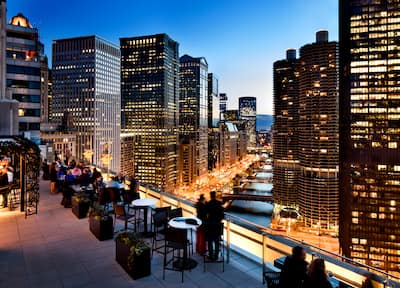
Paul Oswell is a British award-winning journalist and published travel author based in New Orleans, Louisiana in the United States. His books include Bucket List North America and The Great American Road Trip, as well as New Orleans' Historic Hotels. He has also been an editor of and contributor to several guide books/editions published by Dorling Kindersley (owned by Penguin), including New Orleans, Florida, Orlando, Los Angeles, California and The United States. His work has appeared in Conde Nast Traveler, Travel & Leisure (both of which he has written multiple online travel guides for) and The Guardian, as well as dozens of international newspaper and magazine titles, and inflight magazines for major airlines.
Property spotlights
Read more:
Find travel inspiration